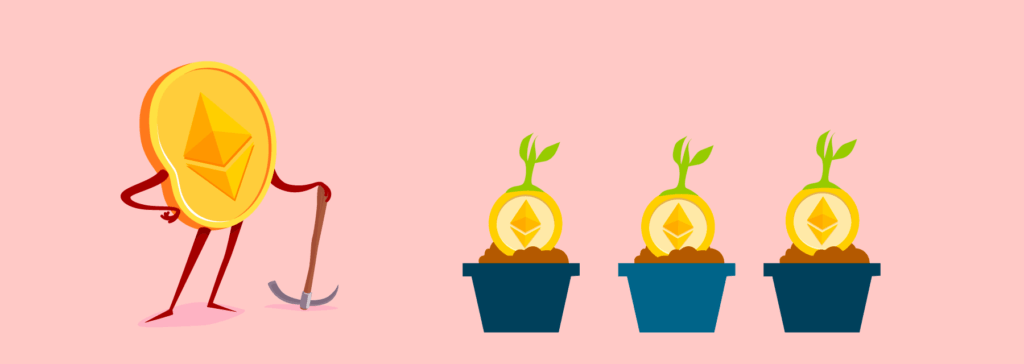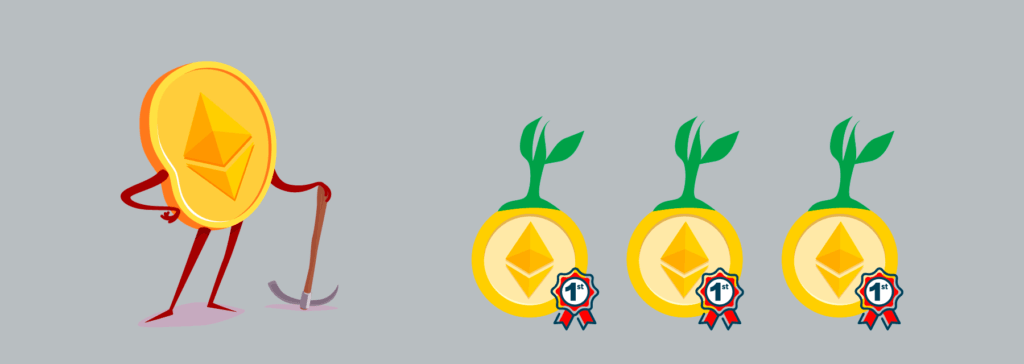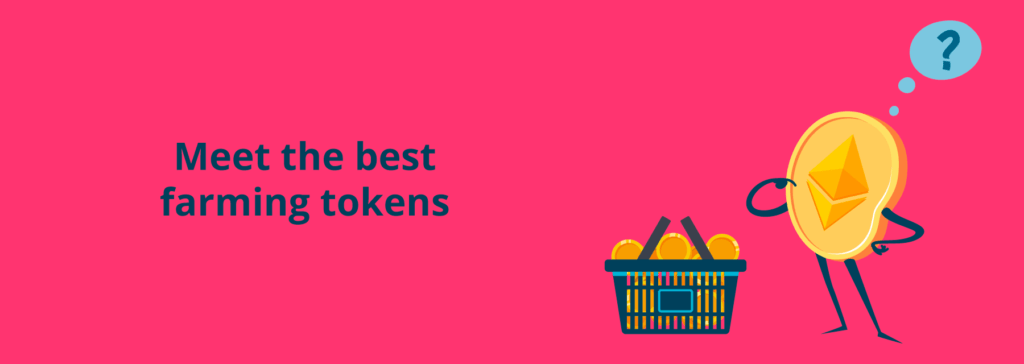The complete guide to yield farming
Yield farming burst onto the scene in mid 2020, and it’s become one of the most lucrative crypto trends to date.
But getting into yield farming can be an uphill battle, requiring you to have some sort of technical understanding.
So, to help you become the best yield farmer in the world, we’re going to teach you everything.
Whether you’re totally new to yield farming or if you’ve been farming since the dawn of DeFi, we’ve got a few tricks up our sleeves that will supercharge your farming.
Grab your coins and get ready to dive into the world of yield farming.
We’ll go slow and break everything down so that you can keep up!
What is yield farming?

In its essence, yield farming is the process of locking up your crypto into a pool and earning interest from it.
Think of it as loaning out your crypto anonymously and getting rewarded for it.
The people taking out crypto loans will pay interest and a cut of that comes back to you.
Under the hood, there’s so much more to yield farming, making it a complex yet lucrative financial tool.
You can leverage, flash loan, and even use strategies to boost your yield farming earnings.
Yield farming is part of the decentralized finance (DeFi) world, meaning that most of the action happens over on the Ethereum network.
As a result, you’ll need to get your hands on some Ethereum to cover the gas fees for your transactions.
You can yield farm over on the Binance Smart Chain, but it’s a new player in the game.
That being said, Binance Smart chain does offer faster transactions and lower fees, making it popular with top yield farmers.
If you opt to yield farm on Binance Smart Chain, you’ll need some Binance Coin to cover those transaction fees.
You can yield farm on both networks at the same time, if you wish.
If you plan on doing this, pick a wallet that works on both blockchains and makes life easier, like MetaMask.
How does yield farming work?

When you want to start yield farming, you’ll need to pick a blockchain to start on.
Ethereum has a decent range of decentralized finance (DeFi) protocols to pick from, meaning that you’ve got more yield farming options.
On the other hand, Binance Smart Chain has cheaper transactions and some rather good yields.
Once you’ve picked one, you’ll want to download and install a wallet to hold the tokens that you’ll gather in your yield farming journey.
MetaMask is a fantastic option here as it supports both chains, and you can add any token from both networks.
It’s also a browser extension so verifying all the transactions is quick, simple and easy.
There are others you can use, but we find MetaMask to be the best option in this situation.
Let’s say you’ve picked Ethereum for your yield farming adventure.
You’ll need to make sure that you’ve got some Ether in your wallet, as this is what’s used to pay the fees.
Once that’s in, you can start your yield farming adventure.
The whole goal of yield farming is to become a liquidity provider.
On regular crypto exchanges, this is done by large institutions that have vast pools of crypto.
But, in DeFi anyone can become a liquidity provider, which levels the playing field.
A liquidity pool is essentially a giant pool of cryptocurrency or tokens that people lock away.
When you add to these pools, you will be told how long it takes to withdraw from the pool.
This time lock gives the protocol time to replace your liquidity and helps prevent liquidity drain attacks, which we’ll talk about in more detail shortly.
These liquidity pools then power marketplaces, kind of like crypto exchanges.
Users of these marketplaces can borrow and exchange tokens, using your liquidity to facilitate the transaction.
These people pay fees for their transactions and interest when they borrow from the pool.
These fees are then distributed back to the liquidity providers as rewards.
The rewards are generally measured as APY and yield farmers will move their tokens around, chasing the highest APY liquidity pools.
Some protocols will pay out extra tokens to liquidity providers, this is known as liquidity mining.
This increases the pool’s APY and makes it more lucrative for farmers.
These liquidity provider tokens can then be staked in other pools, generating further rewards.
As you can imagine, you will then generate more passive income and can stake that in other liquidity pools and so on.
Yield farmers then chase the best APY to generate the most income.
The biggest and best yield farmers will be constantly switching up the pools they’re providing liquidity to based on the APY they’re generating.
And that’s yield farming.
The deeper you go into yield farming, the more APY you can make.
There are 3 areas that you need to fine tune in your yield farming strategy to max out your earning potential.
Some pools promise a lofty earning potential of 80,640,000% APY, which is a crazy amount of money.
Compare that to the 0.1% or worse that your bank account offers, and you can see why yield farming is so hot.
The 3 areas that you need to optimize are:
- Liquidity mining
- Leverage
- Risk
So, let’s go into more detail about a few of the key areas of yield farming strategy optimization.
After all, if you’re going to yield farm, you want to make a bunch of money!
Liquidity mining

Liquidity mining is a major incentive from yield farming.
It’s where a liquidity pool will pay you out in liquidity provider (LP) tokens.
So, let’s say you provide liquidity to a pool that pays out LP tokens, you’ll earn a higher APY than you would with a pool that doesn’t.
This is known as liquidity mining as it’s like getting block rewards from staking.
You stake your coins and tokens to validate blocks while getting rewards for doing so.
Now, in yield farming you’re not doing any of that, it’s just a similar concept, hence the name.
You can opt to compound your LP tokens, which generates you more APY automatically, or you can withdraw them to provide liquidity in other pools.
The more liquidity mining you do, the more tokens you end up with and the more money you can make.
Leverage

Using leverage in yield farming is the same as in crypto trading.
The aim is to use borrowed money to increase your return potential.
Now, with yield farming you can take leverage and crank it up to 1,000 – which gets scary.
What a lot of farmers do is they deposit coins and use them as collateral to borrow other coins.
They’ll generally get a lot more coins than they deposited, just like when you leverage trade.
They will then use those leveraged coins on another borrowing platform to borrow even more coins.
This allows you to supercharge your earning potential, but it introduces a LOT of risk.
If one coin dips in price and you get liquidated, your entire pot goes poof.
But, by this point you could have 1,000x the coins you originally had, meaning that even a 1% yield will net you a crazy amount of profit.
And this brings us to the 3rd point – risk.
Risk

The secret to scoring 80,640,000% APY is taking a whole bunch of risks.
As the saying goes, you’ve got to buy a ticket to win.
Yield farmers need to take big risks to earn big bucks, but this in turn creates problems in the DeFi ecosystem.
Most of the loans that farmers are taking are under collateralized.
This means that most of the loans are loans on top of loans on top of loans.
Think of it like paying off your credit card by shifting it all to another credit card.
The initial collateral is then susceptible to liquidation if the value of the token or coin drops below a certain level.
The higher the leverage, the smaller the drop in value needed to liquidate the trade.
It then all comes down like a house of cards.
You then have all the fun risks that come with smart contracts and crypto.
First up, smart contracts are full of risks.
These are bugs and vulnerabilities that are present in a lot of smart contracts.
As we explained in our guide to dApps, smart contracts are often rushed or have large portions of the code borrowed.
This leaves plenty of room for error.
Hackers can then exploit the code and drain funds.
Another risk is platform changes.
If a yield farming platform changes, it could break it and destroy the earning potential.
If you’re leveraged on a leveraged trade and the platform updates, creating an unfavorable environment for your strategy, it’s game over.
There are also other risks such as coordinated liquidity pool drain attacks.
These attacks drain liquidity pools, rendering them useless and unable to earn.
If you’re all in on that pool, suddenly your yield farm isn’t earning, and you can’t afford to repay the fees to borrow on your leverage.
Obviously, you don’t have to take any of these risks, but if you do, you could potentially earn an incredible amount of money.
It all depends how deep you want to get into yield farming.
Pros of yield farming

There are a lot of risks attached to yield farming, especially if you’re new to the space.
But, with a bit of practice and testing, you’ll quickly become accustomed to it and comfortable.
If you play your cards right, there are so many advantages of yield farming.
Here are the advantages of yield farming:
- Better interest rates than banks provide
- Fantastic earning potential
- First mover in the new financial system
If you farm effectively and follow the best practices, then you can do well in the yield farming world.
It takes a lot of time to do properly and effectively.
But if you can dedicate the time, you can make a full-time living from yield farming!
Cons of yield farming

Obviously, it’s not all positive in the yield farming world.
There are a lot of negatives and risks that you are exposing yourself to.
So, let’s run through the cons of yield farming!
- Flash farms are dangerous
- Under collateralization can destroy your savings
- Need to dedicate a lot of research time to be profitable
- Smart contracts are not fully audited
- Hackers and attacks are commonplace
- Subject to impermanent loss
In yield farming, there’s a phenomenon known as flash farms.
These are platforms and pools that promise massive amounts of APY but are only around for a short period of time.
Most of the governance and LP tokens are distributed between the founders.
Once the price has pumped up enough, they’ll sell their bags and abandon the project.
Everyone else is left with bags of useless tokens in a best-case scenario.
In a worst-case scenario, you lose all the funds you had in the pool.
Be wary of flash pools as they are incredibly risky.
Can anyone yield farm?

The great thing about yield farming is that absolutely anyone can do it.
As long as you’ve got the crypto needed to provide liquidity and a supported wallet, then you’re good to go.
There is a bit of a learning curve if you’re going from crypto novice to yield farmer, but it’s not impossible.
If you follow this handy guide, you’ll be able to yield farm in no time at all.
To begin farming, simply pick a provider and connect your wallet.
Connecting your wallet is safe and simple to do – it takes the click of a button.
Then you can pick pools to provide liquidity to and begin your yield farming adventure.
There’s no KYC or AML requirements before you can begin in the yield farming world.
So, as long as you’ve got some crypto, you’re all set to go.
There are no restrictions or rules, meaning that everyone and their mother can become yield farmers!
Welcome to farming the 21st century way!
Is yield farming profitable?

Yield farming is a complex process, but if you do it properly by following this guide, then you can become a profitable yield farmer.
By using smart strategies, you can maximize your yield farming income pretty quickly.
If you use all 3 facets of yield farming correctly, then you can make millions of percent in APY.
The 3 principles that you need to balance are:
- Liquidity mining
- Leverage
- Risk
If you manage to balance out these principles, then you will be set for bumper gains.
You will also need to divert a fair amount of time to research and analysis if you’re going to be a first mover.
What this means is that you’ll spend time learning about new liquidity pools and being one of the first in.
This gives you the chance to stock up on liquidity provider (LP) tokens before the masses join the hype train.
You then ride the wave up, sell near the top and move on to the next up and coming pool to repeat the process.
Many people from the DeFi space have given up their full-time jobs to focus on yield farming.
So that’s what you’re up against.
Alternatively, you can use aggregators to give you a list of the best performing pools so that you can just drop in there.
These are handy and save you a lot of time, but they also carry risk.
If a pool is busy, you’ll get less rewards for adding liquidity, unless you have a significant amount of capital.
You need to balance nicely between popular pools and upcoming pools.
Changing the tokens you’re pooling helps you keep your portfolio balanced and diversified as well.
This is known as crop rotation in yield farming.
What risks are involved with yield farming?

Yield farming promises gains and profits beyond your wildest dreams.
But with everything in the crypto world, there’s a lot of risk involved.
Now, the risk in yield farming varies greatly depending on your strategy.
Some strategies are incredibly high risk, while some are just average risk.
Now, no matter what you do in the yield farming world, you’ll always be at risk of impermanent loss.
Impermanent loss is a temporary loss of funds when providing liquidity.
It’s generally described as the difference between holding an asset and providing liquidity.
It happens most commonly where you, the liquidity provider, have to provide both assets in the correct ratio.
If one asset goes up in value, the pool relies on arbitrage traders to ensure that the value of the pool ratio remains exactly the same.
Otherwise, you can suffer impermanent loss.
It’s known as impermanent as if the price balances back out between the 2 assets, then you are back to square one and even.
However, it will be recorded as a loss if you remove liquidity from the pool.
So essentially, if one of the assets goes up in value against the other asset you provide, you can lose money.
For this reason, it’s safer to use assets with lower volatility such as stablecoins where possible.
Starting out with the basic risks that everyone in yield farming face, we’ve got problems with smart contracts.
This could be bugs or vulnerabilities from poorly tested contracts.
These types of problems could lead to pool failure and theft of funds.
Worst case scenario with these risks is complete loss of your money.
There’s no real way to mitigate these risks or protect yourself, you just have to trust the developers.
You can stick to using older and more well-known pools as these are generally tried and tested.
It’s the new pools and protocols that cause the most worry and fear.
So, make sure you do your due diligence.
If you’re a more advanced yield farmer, the biggest risk that you’re exposed to would be under collateralized lending.
If you’re borrowing on borrowed tokens, then you could end up in a world of trouble if one position gets liquidated.
It will wipe out your yield farming empire like a gentle breeze over a house of cards.
Cut down your chances of this happening to you by picking out more secure pairs or borrowing against stablecoins that are immune to price fluctuations.
Aside from that, there’s not much else you can do to mitigate risks.
The best yield farming strategies

There are a number of different strategies out there for yield farming, but some are better than others.
But before we dive into these strategies, we’re going to run you through a couple of risks.
Strategies can become obsolete overnight, so don’t pick one up and think it’ll last you until the end of time.
Protocol and incentive changes are the biggest culprits for this, so stay on top of the protocols and pools that you’re using.
Generally speaking, there will be some communication before an update or change, so keep your eyes peeled in the relevant discord groups.
You can also set up automations through apps like Zapier that will monitor the various chats and notify you when keywords are used.
Now to the fun part – the strategies.
Fortune favors the bold, and this applies to the yield farming world.
One popular strategy is risk taken to the max.
What you want to do is deposit your coins and use them as collateral to borrow more tokens on leverage.
You then use those leveraged tokens to buy more on leverage from another provider and lock those into a high-performance liquidity pool.
You’ll earn far greater rewards than if you use your original stack.
It’s a great way to quickly crank up your APY into the double- or triple-digit realm.
Once your borrow period is up, or you’re ready to close the leverage positions, simply remove from the staking pool and repay the loans.
You can then rinse and repeat this strategy over and over again.
Another popular strategy is known as crop rotation.
This is where you constantly swap coins and tokens to provide liquidity in pools that offer better rewards.
You chase the best deals and rewards, rotating as often as required.
It’s a profitable strategy, but it takes up a lot of time.
You can set up bots and alerts to do the grunt work for you, but you’ll have to execute the trades to move in and out of pools.
If you’ve got the time, this is a fairly low-risk and high yield strategy.
What do I need to start yield farming

Getting started in the yield farming business is simple and easy.
First up, you’ll need to load up on Ether or Binance Coin.
These coins will be used to pay gas fees and to convert into the tokens you want to yield farm with.
So, pick the blockchain you want to farm on and load up on that currency.
You’ll also need a crypto wallet that supports Ethereum or Binance Smart Chain to handle all the transactions.
MetaMask is a fantastic option here, but there are other wallets that you can use.
Check out the best crypto wallets here.
Once you’ve got crypto and a wallet, drop the crypto into that wallet and head on over to the swap exchanges.
There are loads to pick from, but some are better than others.
Generally speaking, the best sites for yield farming are:
From these sites, you can easily swap your crypto into tokens used for yield farming.
You can also add to liquidity pools from these sites as well.
These sites are all tried and tested and are generally safe to use, so you shouldn’t run into too many problems.
Which are the best yield farms?

Picking out a site to yield farm on can be tricky, especially with all the flash farms and scams around.
New farms are popping up all the time, so you can be forgiven for feeling a little lost and confused.
It’s important to pick a farm to use that’s not going to rug pull you, otherwise you’ll lose all your money in the blink of an eye.
People actively build these farms as they can make a fortune in a small space of time.
Once they’ve made enough money from a flash farm, they tear it down and launch a new one.
It’s a rinse and repeat world, so stick to those that have been around for a while and have earned a solid reputation.
Generally speaking, the best farms are:
These farms have been around for a while now and have earned a solid reputation.
This doesn’t mean that they’re immune to hacks, attacks and rug pulls, but they are safer than some others out there.
There is a whole world of other farms out there operating on other blockchains.
Binance Smart Chain is home to a plethora of farms, but some are not to be trusted.
New farms launch every day, with an alarming percentage turning out to be flash farms and rug pulls.
If you want to use Binance Smart Chain, stick with Pancake.
If you want a farm that’s on both, PancakeBunny is a fantastic choice.
Which token is the best for yield farming?

When it comes to yield farming, you need to pick some tokens to use in liquidity pools.
There are dozens to pick from, with more cropping up all the time.
This can make it hard to pick one that offers good potential returns and is safe.
The younger tokens tend to offer the biggest rewards, but they’re also the biggest risks.
So, our advice is this – pick and mix.
You don’t have to be tied into a single “crop”, just like a real-life farmer.
Mix up the crops a bit and have a bit of everything going on.
The great part about yield farming is that there’s no limits.
This means you can get started for as little as a fraction of a cent.
However, if you want something a bit more meaningful, you can opt to go for the big boys.
These are the tokens that have been around for a while and are fairly well established.
The returns on these without leveraging are generally around 1% daily, which isn’t terrible.
You can provide liquidity in just about any currency you want, which is incredible.
Even your traditional cryptocurrencies such as XTZ, BCH, EOS and XRP generate high yield.
So don’t think that you’ve got to use a dodgy altcoin in order to farm well.
You can use just about any cryptocurrency to farm with!
How much money can I make from yield farming?
The sole purpose of yield farming is to make money, let’s face it.
It’s still in its infancy so using it to actually take out a loan for something useful isn’t reasonable.
So, you’re probably wondering how much you can make from yield farming, right?
Unfortunately, there’s no answer to that question.
But, what we can tell you is that there’s the potential to earn a small fortune, if you can dedicate the time.
The more risk you take, the greater your earning potential.
If you use leverage borrowing to borrow even more on leverage, then you can instantly crank up your earning potential to the max.
But, one wrong move or one bad market movement and you could lose everything.
It’s a tricky game to play, but if you follow our guide and time it right, you can make a small fortune in no time at all.
Obviously the more you have to begin with, the more you will earn from yield farming, but that goes for everything in life.
The most important thing is that you take it at your own pace.
Don’t try to chase 6 figure gains just because you saw some YouTuber do it – that’s the fastest way to lose everything.
Use a strategy that suits your yield farming goals and only farm with what you can afford to lose.
Do your homework and read up before you plough into a new farm or token, it could save you a lot of heartache down the line.
Most importantly, have fun while farming!
Yield farming is here to stay!

Yield farming is still in its infancy, and it’s growing with every passing week.
There’s more than $32 billion in terms of yield farming market cap, which is an impressive sum of money.
As time goes on, we’ll see more audited smart contracts and less flash farms, making the space safer and less volatile.
While that will cut down the excitement, there will still be more money to be made than leaving your funds in the bank.
Whatever you do, enjoy yield farming responsibly!